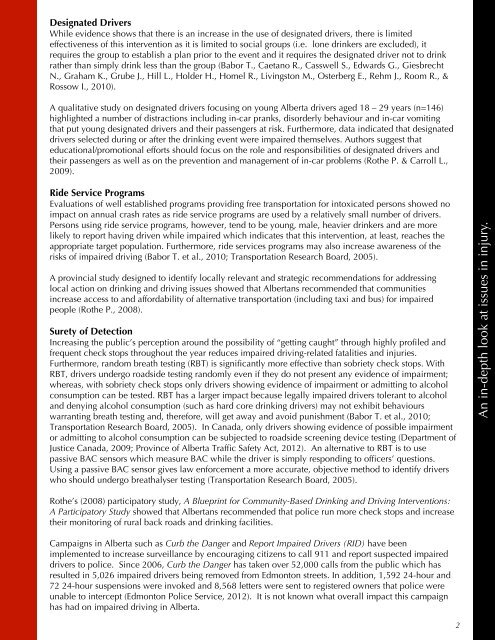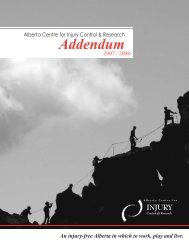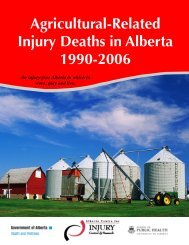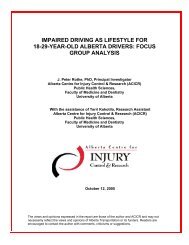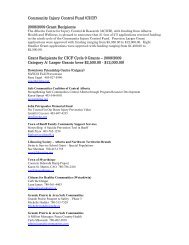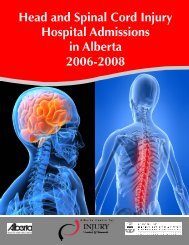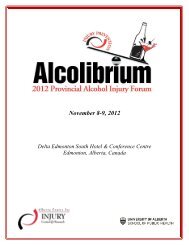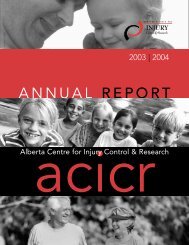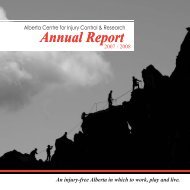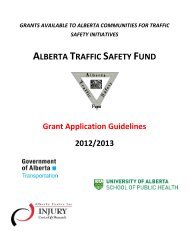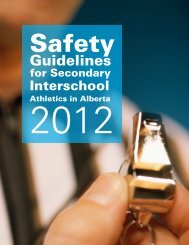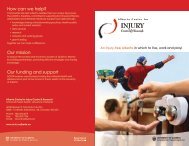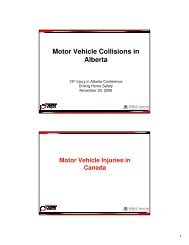Impaired Driving - Alberta Centre for Injury Control & Research
Impaired Driving - Alberta Centre for Injury Control & Research
Impaired Driving - Alberta Centre for Injury Control & Research
You also want an ePaper? Increase the reach of your titles
YUMPU automatically turns print PDFs into web optimized ePapers that Google loves.
Designated Drivers<br />
While evidence shows that there is an increase in the use of designated drivers, there is limited<br />
effectiveness of this intervention as it is limited to social groups (i.e. lone drinkers are excluded), it<br />
requires the group to establish a plan prior to the event and it requires the designated driver not to drink<br />
rather than simply drink less than the group (Babor T., Caetano R., Casswell S., Edwards G., Giesbrecht<br />
N., Graham K., Grube J., Hill L., Holder H., Homel R., Livingston M., Osterberg E., Rehm J., Room R., &<br />
Rossow I., 2010).<br />
A qualitative study on designated drivers focusing on young <strong>Alberta</strong> drivers aged 18 – 29 years (n=146)<br />
highlighted a number of distractions including in-car pranks, disorderly behaviour and in-car vomiting<br />
that put young designated drivers and their passengers at risk. Furthermore, data indicated that designated<br />
drivers selected during or after the drinking event were impaired themselves. Authors suggest that<br />
educational/promotional ef<strong>for</strong>ts should focus on the role and responsibilities of designated drivers and<br />
their passengers as well as on the prevention and management of in-car problems (Rothe P. & Carroll L.,<br />
2009).<br />
Ride Service Programs<br />
Evaluations of well established programs providing free transportation <strong>for</strong> intoxicated persons showed no<br />
impact on annual crash rates as ride service programs are used by a relatively small number of drivers.<br />
Persons using ride service programs, however, tend to be young, male, heavier drinkers and are more<br />
likely to report having driven while impaired which indicates that this intervention, at least, reaches the<br />
appropriate target population. Furthermore, ride services programs may also increase awareness of the<br />
risks of impaired driving (Babor T. et al., 2010; Transportation <strong>Research</strong> Board, 2005).<br />
A provincial study designed to identify locally relevant and strategic recommendations <strong>for</strong> addressing<br />
local action on drinking and driving issues showed that <strong>Alberta</strong>ns recommended that communities<br />
increase access to and af<strong>for</strong>dability of alternative transportation (including taxi and bus) <strong>for</strong> impaired<br />
people (Rothe P., 2008).<br />
Surety of Detection<br />
Increasing the public’s perception around the possibility of “getting caught” through highly profiled and<br />
frequent check stops throughout the year reduces impaired driving-related fatalities and injuries.<br />
Furthermore, random breath testing (RBT) is significantly more effective than sobriety check stops. With<br />
RBT, drivers undergo roadside testing randomly even if they do not present any evidence of impairment;<br />
whereas, with sobriety check stops only drivers showing evidence of impairment or admitting to alcohol<br />
consumption can be tested. RBT has a larger impact because legally impaired drivers tolerant to alcohol<br />
and denying alcohol consumption (such as hard core drinking drivers) may not exhibit behaviours<br />
warranting breath testing and, there<strong>for</strong>e, will get away and avoid punishment (Babor T. et al., 2010;<br />
Transportation <strong>Research</strong> Board, 2005). In Canada, only drivers showing evidence of possible impairment<br />
or admitting to alcohol consumption can be subjected to roadside screening device testing (Department of<br />
Justice Canada, 2009; Province of <strong>Alberta</strong> Traffic Safety Act, 2012). An alternative to RBT is to use<br />
passive BAC sensors which measure BAC while the driver is simply responding to officers’ questions.<br />
Using a passive BAC sensor gives law en<strong>for</strong>cement a more accurate, objective method to identify drivers<br />
who should undergo breathalyser testing (Transportation <strong>Research</strong> Board, 2005).<br />
An in-depth look at issues in injury.<br />
Rothe’s (2008) participatory study, A Blueprint <strong>for</strong> Community-Based Drinking and <strong>Driving</strong> Interventions:<br />
A Participatory Study showed that <strong>Alberta</strong>ns recommended that police run more check stops and increase<br />
their monitoring of rural back roads and drinking facilities.<br />
Campaigns in <strong>Alberta</strong> such as Curb the Danger and Report <strong>Impaired</strong> Drivers (RID) have been<br />
implemented to increase surveillance by encouraging citizens to call 911 and report suspected impaired<br />
drivers to police. Since 2006, Curb the Danger has taken over 52,000 calls from the public which has<br />
resulted in 5,026 impaired drivers being removed from Edmonton streets. In addition, 1,592 24-hour and<br />
72 24-hour suspensions were invoked and 8,568 letters were sent to registered owners that police were<br />
unable to intercept (Edmonton Police Service, 2012). It is not known what overall impact this campaign<br />
has had on impaired driving in <strong>Alberta</strong>.<br />
2


